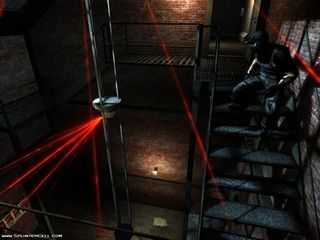Can you really rocket jump?
Games vs science: let the showdown commence!
Laser security beams
In-game example: Splinter Cell: Chaos Theory. Laser beams attached to alarms, covering museums and bank floors, intended to deter the player from advancing.

You’ve seen it. A security system where laser beams criss-cross rooms. Except, in showing off where the lasers are, they’re giving away exactly where you need to step in order to bypass it. While the typical grid system is a bit of an exaggeration, there are security devices readily available that’ll cover doorways, porches, etc. The beams are, of course, invisible, and will be able to tell the difference between The Jackal and, well, a jackal. So not only is it possible, but it’s now commonplace enough that electronics stores sell them to the great unwashed. Visit here to see the principles of an awesome, game-style laser trap, writ small.

Guided rockets
In-game example: Crysis. A guided rocket that follows your laser-targeting beam like a cat chasing a mouse pointer.

Crysis is the most recent of numerous games to suggest that a rocket fired from a shoulder-mounted launcher could then be controlled after the fact by dragging a laser beam around. Aside from the ludicrous proposition that you could counteract the thrust generated by a rocket sufficiently in order to turn it in a tight space, the idea of guiding a missile around and around like a donkey after a carrot is absurd. However there are laser guided bombs (the US AGM-65 Maverick air-to-surface guided missile, for example), that can be controlled to home in on designated targets after being dropped from a great height. In optimal conditions. By massively powerful jets.

Biomods
In-game example: Deus Ex. Electronic augmentations to the human body that increases the user’s reflexes, strength, etc.
The theory is simple: plug a bit of technology into your arm and suddenly you’ll be able to crush a giraffe’s skull. And other such wholesome gaming activities. However, the reality of body modification is currently based in helping enable disabled people: there’s a technology called BrainGate that enables paraplegic people to control a computer’s mouse cursor, reading the intended movements and enabling the connected PC to control things. Further research has seen the replacement of severed limbs with fully functioning robotic arms, made by Dean Kamen, creator of the Segway. Visit here to see him show it off.

Sign up to the GamesRadar+ Newsletter
Weekly digests, tales from the communities you love, and more
Most Popular

